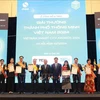Vietnam was likely to be at relatively high risk of earthquakes although the country was not located in the “Ring of Fire”, where a large number of the world’s earthquakes occur, warned scientists.
They made the warning at an international workshop on earthquake and tsunami hazards and early warning systems in Asia-Pacific, in Hanoi on Sept. 5-6, hosted by the Vietnam Institute of Geophysics.
The workshop was an opportunity for scientists from Russia , New Zealand , Indonesia , Italy and Vietnam to discuss natural disaster early warning methods, helping to mitigate human and property losses.
Vietnam was recorded to be exposed to earthquakes with relatively high intensity measuring at 6.7-6.8 on the Richter scale on several-hundred-km fault zones such as the Hong River , Chay River , Son La, Ma River and the 109 fault zone.
A number of major urban centres were located on these zones, which meant a likelihood of strong future earthquakes. Hanoi , for example, was predicted to be susceptible to magnitude 8 quakes.
Scientists from the Vietnam Institute of Geophysics said Vietnam ’s central coast was the most vulnerable area in the country for a tsunami resulting from earthquakes at the Manila trench. From there, a tsunami would take about two hours to reach the Vietnam coast.
Participants discussed issues relating to the possibility of earthquake and tsunami in Vietnam and frequent earthquake areas like Japan , Indonesia and New Zealand .
At the event, foreign scientists introduced early warning solutions for the Asia-Pacific region, including an earthquake and tsunami impact mitigation project in Vietnam , and tsunami scenarios on the East Sea./.
They made the warning at an international workshop on earthquake and tsunami hazards and early warning systems in Asia-Pacific, in Hanoi on Sept. 5-6, hosted by the Vietnam Institute of Geophysics.
The workshop was an opportunity for scientists from Russia , New Zealand , Indonesia , Italy and Vietnam to discuss natural disaster early warning methods, helping to mitigate human and property losses.
Vietnam was recorded to be exposed to earthquakes with relatively high intensity measuring at 6.7-6.8 on the Richter scale on several-hundred-km fault zones such as the Hong River , Chay River , Son La, Ma River and the 109 fault zone.
A number of major urban centres were located on these zones, which meant a likelihood of strong future earthquakes. Hanoi , for example, was predicted to be susceptible to magnitude 8 quakes.
Scientists from the Vietnam Institute of Geophysics said Vietnam ’s central coast was the most vulnerable area in the country for a tsunami resulting from earthquakes at the Manila trench. From there, a tsunami would take about two hours to reach the Vietnam coast.
Participants discussed issues relating to the possibility of earthquake and tsunami in Vietnam and frequent earthquake areas like Japan , Indonesia and New Zealand .
At the event, foreign scientists introduced early warning solutions for the Asia-Pacific region, including an earthquake and tsunami impact mitigation project in Vietnam , and tsunami scenarios on the East Sea./.



















